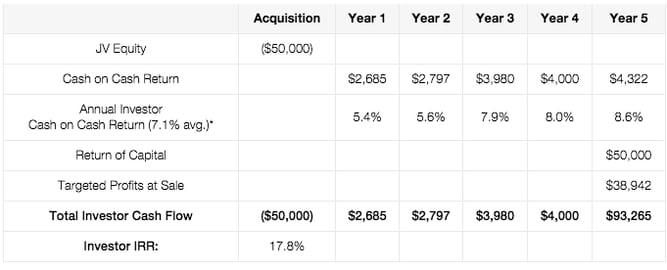Any savvy investor knows that reading a stock summary or private real estate investment offering memorandum comes with its own unique metrics. All investments are not cut from the same cloth and there is a bit of a learning curve to get up to speed on different industry terms.
For example, reading the stats on a real estate stock means deciphering measures such as the P/E ratio and EPS (earnings per share). Analyzing direct real estate offerings is a completely different ballgame. Two of the key metrics to understand are targets for IRR (Internal Rate of Return) and cash-on-cash returns.
The IRR of a real estate investment is defined as the “annualized effective compounded return rate”. Some investors might be more familiar with another common term?—?the Annual Average Return (AAR). Investors typically see that annualized rate of return in mutual funds that report historical returns for say a three-, five- or 10-year period. However, IRR is a preferred measure for real estate, because it takes into account an important factor that AAR does not?—?the time value of money.
There are two key differences between an IRR and an AAR.
- An IRR factors compounding into the calculation whereas an AAR does not take compounding into consideration.
- An IRR is time-sensitive. For example, the faster the distribution of returns, the higher the IRR will be when all other factors remain constant. AAR is commonly defined as the arithmetic mean of a series of rates of return.
One example to help put some of these measures in perspective is CrowdStreet’s posting of Timber Oaks Apartments, a multifamily investment opportunity in the Dallas metro area. The series of targeted cash flows for Timber Oaks is both a 22.7% AAR and a 17.8% IRR. The targeted outcome is different because the formulas account for time differently.

As you can see in this series of cash flows, based on a $50,000 investment, we are targeting a total return of $56,726 (total cash-on-cash returns of $17,784 throughout the holding period plus $38,942 of total profits upon sale). Since we are assuming a 5-year holding period, this means we are targeting an AAR to investors of $11,345 ($56,726 / 5) or 22.7% ($11,345 / $50,000). Alternatively, when using the time-sensitive and compounding methodology of an IRR to calculate a return on this same series of cash flows, it yields a 17.8% IRR.
Another important measure for investment opportunities is cash-on-cash returns. Simply put, this calculation determines the income on the cash invested. It is relevant to real estate because investors and developers often leverage their own equity with additional layers of financing when making direct real estate investments. The cash-on-cash return is the annual dollar income divided by the total dollar investment.
Finally, another term frequently used when discussing the purchase and sale of investment property is the capitalization or “cap” rate. The cap rate is calculated by dividing the net operating income (NOI) by the cost or sale price of a property. For example, if an apartment complex has an annual NOI of $500,000 and sells for $10 million, then the property sold at a cap rate of 5%. Some investors also make the distinction of calculating the “trailing cap rate,” which is derived by dividing the property’s trailing 12-month actual net income rather than any future predictions of NOI.
Analyzing different investment metrics can, at times, seem like wading through a thick fog of alphabet soup. The key for crowdfunding investors is to make sure to understand the differences and use the same measures to provide an “apples-to-apples” comparison when considering potential investment opportunities.


